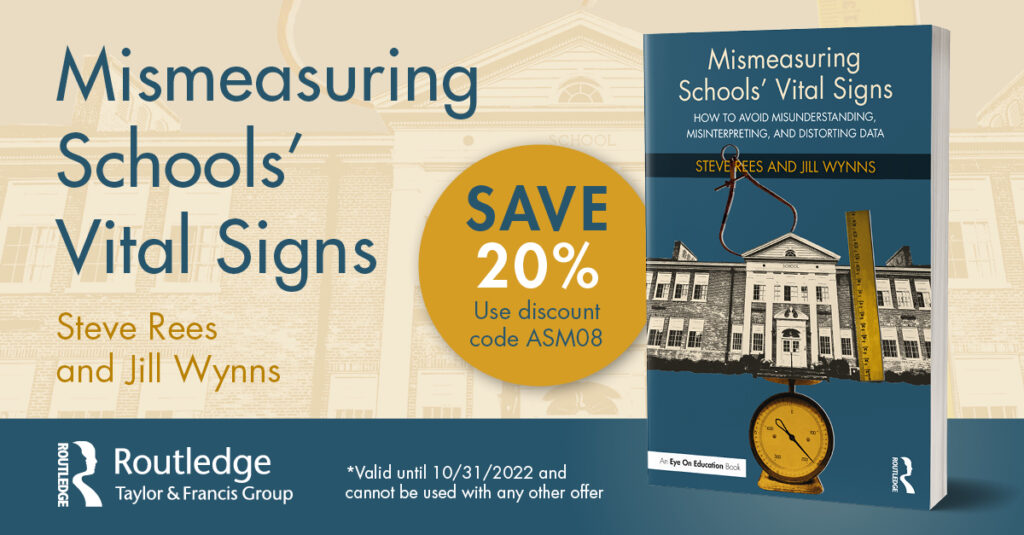Chapter 2
Twisting test results and missing sound evidence of learning
Table of Contents
Chapter 2 Overview
This chapter is about the misinterpretation of test results. We discuss disregard of a test’s purpose, the misunderstanding of what a test might measure, the degree of imprecision and uncertainty inherent in that measure, the choice of the wrong metric, the disregard of spread and over-attentiveness to central tendency, and more. We look closely at the mismeasurement of growth, which is so central to evaluation of student-level, school-level and district-level progress. You’ll learn about the myth of Lake Wobegon, and the history of misunderstanding of norms on national tests.
Chapter 2 Excerpt
Chapter 2 References
Cannell, John Jacob, How Public Educators Cheat on Standardized Tests, Friends of Education (1989), 125 pages. Retrieved on March 15, 2020 from https://files.eric.ed.gov/fulltext/ED314454.pdf
Hattie, John, Visible Learning: A Synthesis of Over 800 Meta-Analyses Relating to Achievement,Routledge (2008), 259 pages.
Popham, W. James, “The right test for the wrong reason,” Phi Delta Kappan, August 30, 2014, 96 (1), pages 46-52.
Popham, W. James, “Why Assessment Illiteracy Is Professional Suicide,” Educational Leadership Magazine, ASCD (September 2004), vol. 62, no. 1, pgs. 82-83.
Rankin, Jenny, dissertation “Over-the-Counter Data’s Impact on Educators’ Data Analysis Accuracy,” Northcentral University, Arizona (2013). Accessed on March 3, 2019, from https://pqdtopen.proquest.com/doc/1459258514.html?FMT=ABS.
Rankin, Jenny, “Remedying Educators’ Data Analysis Errors with Over-the-Counter Data,” CCNews: Newsletter of the California Council on Teacher Education, vol. 24, no. 4 (December 2013), pgs 14-21. Accessed on March 8, 2019, from http://ccte.org/wp-content/pdfs/newsletters/ccte-news-2013-winter.pdf
Rankin, Jenny, Standards for Reporting Data to Educators, Routledge (2016), 140 pages.
Rasmussen, Steven, “Smarter Balanced Tests—One Year Later, Same Shameful Tests,“ accessed on September 25, 2020, from http://mathedconsulting.com/2016/03/smarter-balanced-tests-one-year-later-same-shameful-tests/
Rasmussen, Steven, “The Smarter Balanced Common Core Mathematics Tests Are Fatally Flawed and Should Not Be Used: An In-Depth Critique of the Smarter Balanced Tests for Mathematics,” SR Education Associates (March 2015). Accessed on September 25, 2020, from http://mathedconsulting.com/wp-content/uploads/2015/04/Common-Core-Tests-Fatally-Flawed.pdf
Standards for Educational and Psychological Testing, American Educational Research Association (2014), 230 pages.
Shaywitz, Sally E., New England Journal of Medicine, January 29, 1998; Vol. 338(5), pages 307-12.
“SLDS Data Use Standards: Knowledge, Skills, and Professional Behaviors for Effective Data Use – Master Standards for School and District Leadership.” U.S. Department of Education. Washington, DC (2016): National Center for Education Statistics, 11 pages.

Chapter 2 Data Visualizations
Figure 2.3 - College going rate of Class of 2018
This leaderboard compares the rate at which Morgan Hill’s students in the class of 2018 enrolled in college, compared to students in 15 similar districts. The students we’re examining (the cohort) are those who were enrolled as freshmen four years prior. (Sadly, as of September 2022, this is the most current data available in California.)
But play with the evidence. Want to compare Morgan Hill’s students’ college choices with those of their neighboring district, Gilroy? Mouse over “Gilroy” label on the left side of the left-most panel. Gilroy’s graduating class of 2018 made different choices, with fewer going to four-year colleges. Now change the subgroup from “all students” to “girls.” Then switch to “boys.” Quite a difference.
Figure 2.6 - Second-graders' scores on two reading tests
You’ll see 2nd graders’ reading scores on two tests, given within weeks of each other in the Fall of 2019. But you can change that. Go to the settings in the left-most panel. Click on 3rd-graders for both “x” and “y” axes. Now try the bottom setting and select EL students only. What questions come to mind? I can’t help but wonder why some EL students are still considered to be EL if their reading score are far ahead of their grade-level peers, sometimes on both tests.
Now mouse over the field itself. Blue dots are students getting regular, tier 1 instruction. Tan/gold dots are students getting tier 2 support in reading. The horizontal axis reflects students’ scores on the Fountas & Pinnell (F&P) benchmark assessment, largely a test of reading accuracy and speed, called a running record. The vertical axis reflects students’ scores on the Measure of Academic Progress, an interim assessment from Northwest Evaluation Association. It is mainly a measure of reading comprehension.
The degree to which F&P results disagree with the results of the Measure of Academic Progress is visible by noting the tall column of dots at any point on the F&P scale. The columns in the middle of the F&P scale are tallest, revealing that the two tests produce very different results for the majority of students in the middle, closest to grade level (according to F&P).
Figure 2.6

